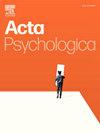Unveiling the neural mechanisms of acute aerobic exercise on inhibitory control among young adults with obesity: Insights from an ERP study
IF 2.7
4区 心理学
Q2 PSYCHOLOGY, EXPERIMENTAL
引用次数: 0
Abstract
Obesity has become a prominent public health concern worldwide and is associated with adverse cognitive function. Exercise, particularly aerobic exercise, is known to benefit for weight loss and cognitive function. However, whether acute aerobic exercise could yield benefits to obese individuals and the precise brain mechanisms of action remain poorly understood. The study aimed to investigate whether acute aerobic exercise could improve inhibitory control among obese individuals and what neuroelectric mechanisms are implicated. A 3 (session: control, low-intensity exercise, moderate-intensity exercise) × 2 (congruency: congruent, incongruent) within-subject design was conducted. 18 obese young male adults underwent three sessions of 30-min interventions in a counterbalanced order seperated by five days: moderate-intensity aerobic exercise (MIE), low-intensity aerobic exercise (LIE) and a control session (a sedentary period of seated rest). The Flanker task and EEG recordings (N2 and P3 amplitude) were investigated following exercise and the control treatment. Results showed that the N2 amplitude following MIE was larger than the control session, whereas a larger N2 and reduced congruent P3 amplitude was observed following MIE than LIE. However, no main effect of the session was found for reaction time and accuracy, but a significant main effect of congruency was observed. These findings suggest acute moderate-intensity aerobic exercise may modulate brain activity through enhanced recruitment of attentional resources for cognitive control and conflict monitoring in adults with obesity.
揭示急性有氧运动对肥胖青壮年抑制控制的神经机制:ERP研究的启示
肥胖症已成为全球突出的公共健康问题,并与认知功能不良有关。众所周知,运动,尤其是有氧运动,有利于减肥和认知功能。然而,人们对急性有氧运动能否给肥胖者带来益处以及确切的大脑作用机制仍知之甚少。本研究旨在探讨急性有氧运动是否能改善肥胖者的抑制控制能力,以及其中涉及的神经电机制。研究采用了 3(疗程:对照组、低强度运动、中等强度运动)×2(一致性:一致、不一致)的受试者内设计。18 名肥胖的年轻男性成年人按平衡顺序接受了三次 30 分钟的干预,每次间隔 5 天:中等强度有氧运动(MIE)、低强度有氧运动(LIE)和对照组(坐着休息)。在运动和对照组治疗后,对 Flanker 任务和脑电图记录(N2 和 P3 振幅)进行了调查。结果显示,MIE 后的 N2 波幅大于对照组,而 MIE 后的 N2 波幅大于 LIE,P3 波幅小于 LIE。然而,在反应时间和准确性方面,没有发现该环节的主效应,但却观察到了一致性的显著主效应。这些研究结果表明,急性中等强度的有氧运动可能会通过增强肥胖症成人在认知控制和冲突监控方面的注意力资源调控大脑活动。
本文章由计算机程序翻译,如有差异,请以英文原文为准。
求助全文
约1分钟内获得全文
求助全文
来源期刊

Acta Psychologica
PSYCHOLOGY, EXPERIMENTAL-
CiteScore
3.00
自引率
5.60%
发文量
274
审稿时长
36 weeks
期刊介绍:
Acta Psychologica publishes original articles and extended reviews on selected books in any area of experimental psychology. The focus of the Journal is on empirical studies and evaluative review articles that increase the theoretical understanding of human capabilities.
 求助内容:
求助内容: 应助结果提醒方式:
应助结果提醒方式:


